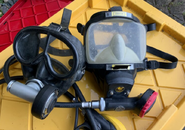Don't be too hasty in criticizing the OP's initial fascination with full face masks, which I too possessed decades ago, and with far less experience than I have today -- well before the advent of formal FFM classes.
There are admittedly complexities to FFMs, which eclipse that novelty of finally being able to breathe both through the nose and mouth.
Excerpted from a related thread:
"The drawback, from someone who has been using them for decades, is the frequent lack of "over-pressure" mask options that serve to make them both safer, in terms of further venting CO2; which also serves to make flooding all-but impossible; and provides an improved, far more natural experience of breathing. Basically, the regulator involved is allowed to slightly free-flow and that extra air use, provided that it is properly tuned, is really negligible.
"Other unusual issues include the buoyancy of FFMs in the shallows (due to their increased volume) and the necessity, at times, of adding ballasts, which are ridiculously expensive, across brands, for what they actually are; so too, there is the all-too common tunnel vision of most models, that few ever realize or take into consideration. Add ballasts, usually mounted somewhere near the temples, and it becomes even worse and darker -- much like diving while sporting blinders.
"Adding ambient valves for breathing on the surface, without the use of the tank; optional rail systems, for lights, cameras, etc, can make things even more costly, complex, and heavier. Gas switch blocks are also commonly used and add yet a further level of complexity, for FFM use.
"Getting accustomed to using a Valsalva nose block, on the FFM interior, for equalization, may take some practice, for those FFM models which don't allow for any nose access. Stories of vastly increased air use are largely overblown, once the diver becomes accustomed to the masks.
"The issues with FFM safety are also a bit overplayed, and I began their use well before there were any specialty classes. We just practiced donning and doffing them in a pool until it became almost automatic. Admittedly, there are some potential safety issues with the removal of FFMs in colder water (the prospect of sudden bradycardia) have been covered on SB, and does deserve some consideration . . ."
There are admittedly complexities to FFMs, which eclipse that novelty of finally being able to breathe both through the nose and mouth.
Excerpted from a related thread:
"The drawback, from someone who has been using them for decades, is the frequent lack of "over-pressure" mask options that serve to make them both safer, in terms of further venting CO2; which also serves to make flooding all-but impossible; and provides an improved, far more natural experience of breathing. Basically, the regulator involved is allowed to slightly free-flow and that extra air use, provided that it is properly tuned, is really negligible.
"Other unusual issues include the buoyancy of FFMs in the shallows (due to their increased volume) and the necessity, at times, of adding ballasts, which are ridiculously expensive, across brands, for what they actually are; so too, there is the all-too common tunnel vision of most models, that few ever realize or take into consideration. Add ballasts, usually mounted somewhere near the temples, and it becomes even worse and darker -- much like diving while sporting blinders.
"Adding ambient valves for breathing on the surface, without the use of the tank; optional rail systems, for lights, cameras, etc, can make things even more costly, complex, and heavier. Gas switch blocks are also commonly used and add yet a further level of complexity, for FFM use.
"Getting accustomed to using a Valsalva nose block, on the FFM interior, for equalization, may take some practice, for those FFM models which don't allow for any nose access. Stories of vastly increased air use are largely overblown, once the diver becomes accustomed to the masks.
"The issues with FFM safety are also a bit overplayed, and I began their use well before there were any specialty classes. We just practiced donning and doffing them in a pool until it became almost automatic. Admittedly, there are some potential safety issues with the removal of FFMs in colder water (the prospect of sudden bradycardia) have been covered on SB, and does deserve some consideration . . ."




